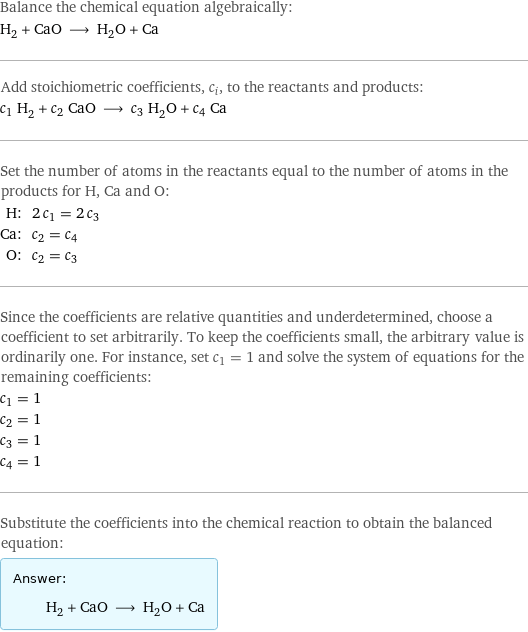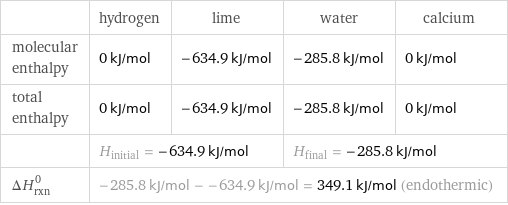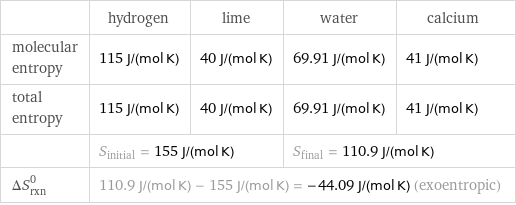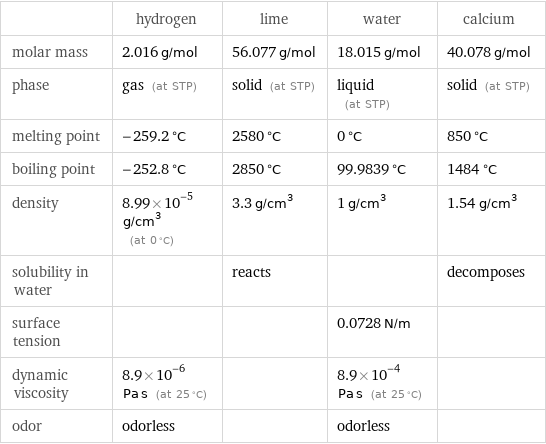Input interpretation

H_2 hydrogen + CaO lime ⟶ H_2O water + Ca calcium
Balanced equation

Balance the chemical equation algebraically: H_2 + CaO ⟶ H_2O + Ca Add stoichiometric coefficients, c_i, to the reactants and products: c_1 H_2 + c_2 CaO ⟶ c_3 H_2O + c_4 Ca Set the number of atoms in the reactants equal to the number of atoms in the products for H, Ca and O: H: | 2 c_1 = 2 c_3 Ca: | c_2 = c_4 O: | c_2 = c_3 Since the coefficients are relative quantities and underdetermined, choose a coefficient to set arbitrarily. To keep the coefficients small, the arbitrary value is ordinarily one. For instance, set c_1 = 1 and solve the system of equations for the remaining coefficients: c_1 = 1 c_2 = 1 c_3 = 1 c_4 = 1 Substitute the coefficients into the chemical reaction to obtain the balanced equation: Answer: | | H_2 + CaO ⟶ H_2O + Ca
Structures

+ ⟶ +
Names

hydrogen + lime ⟶ water + calcium
Reaction thermodynamics
Enthalpy

| hydrogen | lime | water | calcium molecular enthalpy | 0 kJ/mol | -634.9 kJ/mol | -285.8 kJ/mol | 0 kJ/mol total enthalpy | 0 kJ/mol | -634.9 kJ/mol | -285.8 kJ/mol | 0 kJ/mol | H_initial = -634.9 kJ/mol | | H_final = -285.8 kJ/mol | ΔH_rxn^0 | -285.8 kJ/mol - -634.9 kJ/mol = 349.1 kJ/mol (endothermic) | | |
Entropy

| hydrogen | lime | water | calcium molecular entropy | 115 J/(mol K) | 40 J/(mol K) | 69.91 J/(mol K) | 41 J/(mol K) total entropy | 115 J/(mol K) | 40 J/(mol K) | 69.91 J/(mol K) | 41 J/(mol K) | S_initial = 155 J/(mol K) | | S_final = 110.9 J/(mol K) | ΔS_rxn^0 | 110.9 J/(mol K) - 155 J/(mol K) = -44.09 J/(mol K) (exoentropic) | | |
Equilibrium constant
![Construct the equilibrium constant, K, expression for: H_2 + CaO ⟶ H_2O + Ca Plan: • Balance the chemical equation. • Determine the stoichiometric numbers. • Assemble the activity expression for each chemical species. • Use the activity expressions to build the equilibrium constant expression. Write the balanced chemical equation: H_2 + CaO ⟶ H_2O + Ca Assign stoichiometric numbers, ν_i, using the stoichiometric coefficients, c_i, from the balanced chemical equation in the following manner: ν_i = -c_i for reactants and ν_i = c_i for products: chemical species | c_i | ν_i H_2 | 1 | -1 CaO | 1 | -1 H_2O | 1 | 1 Ca | 1 | 1 Assemble the activity expressions accounting for the state of matter and ν_i: chemical species | c_i | ν_i | activity expression H_2 | 1 | -1 | ([H2])^(-1) CaO | 1 | -1 | ([CaO])^(-1) H_2O | 1 | 1 | [H2O] Ca | 1 | 1 | [Ca] The equilibrium constant symbol in the concentration basis is: K_c Mulitply the activity expressions to arrive at the K_c expression: Answer: | | K_c = ([H2])^(-1) ([CaO])^(-1) [H2O] [Ca] = ([H2O] [Ca])/([H2] [CaO])](../image_source/bbf8b684b8ead3bbbe444b334e84dcf2.png)
Construct the equilibrium constant, K, expression for: H_2 + CaO ⟶ H_2O + Ca Plan: • Balance the chemical equation. • Determine the stoichiometric numbers. • Assemble the activity expression for each chemical species. • Use the activity expressions to build the equilibrium constant expression. Write the balanced chemical equation: H_2 + CaO ⟶ H_2O + Ca Assign stoichiometric numbers, ν_i, using the stoichiometric coefficients, c_i, from the balanced chemical equation in the following manner: ν_i = -c_i for reactants and ν_i = c_i for products: chemical species | c_i | ν_i H_2 | 1 | -1 CaO | 1 | -1 H_2O | 1 | 1 Ca | 1 | 1 Assemble the activity expressions accounting for the state of matter and ν_i: chemical species | c_i | ν_i | activity expression H_2 | 1 | -1 | ([H2])^(-1) CaO | 1 | -1 | ([CaO])^(-1) H_2O | 1 | 1 | [H2O] Ca | 1 | 1 | [Ca] The equilibrium constant symbol in the concentration basis is: K_c Mulitply the activity expressions to arrive at the K_c expression: Answer: | | K_c = ([H2])^(-1) ([CaO])^(-1) [H2O] [Ca] = ([H2O] [Ca])/([H2] [CaO])
Rate of reaction
![Construct the rate of reaction expression for: H_2 + CaO ⟶ H_2O + Ca Plan: • Balance the chemical equation. • Determine the stoichiometric numbers. • Assemble the rate term for each chemical species. • Write the rate of reaction expression. Write the balanced chemical equation: H_2 + CaO ⟶ H_2O + Ca Assign stoichiometric numbers, ν_i, using the stoichiometric coefficients, c_i, from the balanced chemical equation in the following manner: ν_i = -c_i for reactants and ν_i = c_i for products: chemical species | c_i | ν_i H_2 | 1 | -1 CaO | 1 | -1 H_2O | 1 | 1 Ca | 1 | 1 The rate term for each chemical species, B_i, is 1/ν_i(Δ[B_i])/(Δt) where [B_i] is the amount concentration and t is time: chemical species | c_i | ν_i | rate term H_2 | 1 | -1 | -(Δ[H2])/(Δt) CaO | 1 | -1 | -(Δ[CaO])/(Δt) H_2O | 1 | 1 | (Δ[H2O])/(Δt) Ca | 1 | 1 | (Δ[Ca])/(Δt) (for infinitesimal rate of change, replace Δ with d) Set the rate terms equal to each other to arrive at the rate expression: Answer: | | rate = -(Δ[H2])/(Δt) = -(Δ[CaO])/(Δt) = (Δ[H2O])/(Δt) = (Δ[Ca])/(Δt) (assuming constant volume and no accumulation of intermediates or side products)](../image_source/09a3e00b7822797c604c92f5329b2f39.png)
Construct the rate of reaction expression for: H_2 + CaO ⟶ H_2O + Ca Plan: • Balance the chemical equation. • Determine the stoichiometric numbers. • Assemble the rate term for each chemical species. • Write the rate of reaction expression. Write the balanced chemical equation: H_2 + CaO ⟶ H_2O + Ca Assign stoichiometric numbers, ν_i, using the stoichiometric coefficients, c_i, from the balanced chemical equation in the following manner: ν_i = -c_i for reactants and ν_i = c_i for products: chemical species | c_i | ν_i H_2 | 1 | -1 CaO | 1 | -1 H_2O | 1 | 1 Ca | 1 | 1 The rate term for each chemical species, B_i, is 1/ν_i(Δ[B_i])/(Δt) where [B_i] is the amount concentration and t is time: chemical species | c_i | ν_i | rate term H_2 | 1 | -1 | -(Δ[H2])/(Δt) CaO | 1 | -1 | -(Δ[CaO])/(Δt) H_2O | 1 | 1 | (Δ[H2O])/(Δt) Ca | 1 | 1 | (Δ[Ca])/(Δt) (for infinitesimal rate of change, replace Δ with d) Set the rate terms equal to each other to arrive at the rate expression: Answer: | | rate = -(Δ[H2])/(Δt) = -(Δ[CaO])/(Δt) = (Δ[H2O])/(Δt) = (Δ[Ca])/(Δt) (assuming constant volume and no accumulation of intermediates or side products)
Chemical names and formulas

| hydrogen | lime | water | calcium formula | H_2 | CaO | H_2O | Ca name | hydrogen | lime | water | calcium IUPAC name | molecular hydrogen | | water | calcium
Substance properties

| hydrogen | lime | water | calcium molar mass | 2.016 g/mol | 56.077 g/mol | 18.015 g/mol | 40.078 g/mol phase | gas (at STP) | solid (at STP) | liquid (at STP) | solid (at STP) melting point | -259.2 °C | 2580 °C | 0 °C | 850 °C boiling point | -252.8 °C | 2850 °C | 99.9839 °C | 1484 °C density | 8.99×10^-5 g/cm^3 (at 0 °C) | 3.3 g/cm^3 | 1 g/cm^3 | 1.54 g/cm^3 solubility in water | | reacts | | decomposes surface tension | | | 0.0728 N/m | dynamic viscosity | 8.9×10^-6 Pa s (at 25 °C) | | 8.9×10^-4 Pa s (at 25 °C) | odor | odorless | | odorless |
Units
